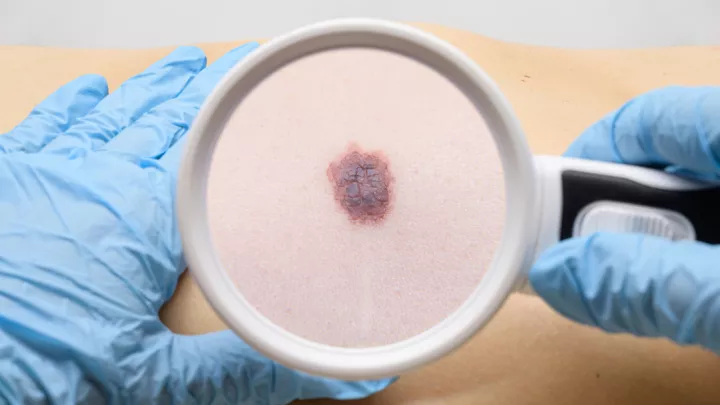Patient story: Mohs surgery and oculoplastic teams collaborate to improve outcomes for skin cancer patients

In May 2024, Larry Anderson, 81, saw a dermatologist at Shenandoah Medical Center in Shenandoah, Iowa, for spots on his eyelid that never seemed to go away.
“I had little, black spots under my eyelid that looked like they were infected,” says Anderson. “They were about a half inch long, slightly raised, and resembled a skin cell that was full of dirt.”
The dermatologist took a few biopsies that confirmed the cells were cancerous. After diagnosis, Anderson was referred to Nebraska Medical Center for further treatment. After an initial evaluation by dermatologist and Mohs surgeon Adam Sutton, MD, MBA, and oculoplastic surgeon Rao Chundury, MD, MBA, Anderson was scheduled for surgery in July 2024.
“During that first visit, Dr. Sutton and Dr. Chundury explained what the procedures would be like,” said Anderson. “Everyone in that office went out of their way to make me feel comfortable. I could tell they were committed to doing the best for their patients.”
Mohs surgery is an advanced surgical technique used to treat skin cancer – precisely removing cancer cells while helping to avoid healthy tissue. The procedure has the highest cure rates and often results in smaller scars. The surgery is performed in a clinical setting under local anesthesia.
Dr. Sutton, a fellowship-trained Mohs surgeon, performed the surgery to remove the cancerous tissue from Anderson’s eyelid. Dr. Sutton was able to check the skin edges in real time to confirm that all the skin cancer had been removed. Once the cancerous cells were removed, Anderson was ready to see Dr. Chundury for reconstructive surgery.
Dr. Chundury, a board-certified ophthalmic plastic and reconstructive surgeon, is an expert at performing reconstructive surgery around the eye. Since the eyelids and tear ducts are such important structures, it’s very important that reconstruction is performed meticulously. If the skin involves the eye in any way, Dr. Chundury helps repair the area so there is minimal impact on the eye’s function and appearance.
Anderson says he was dumbfounded by the results of his surgeries and how smooth the entire process went. “It’s amazing that two doctors can work that closely with each other and know the extent of what they’ve got to do and the timing of it,” he says. “They didn’t send me home with a big bruise on my eye or an open wound. Everything was done in one day.”
"I came here to start our Mohs surgery program and be part of a team that specializes in the treatment of skin cancer of all types,” says Dr. Adam Sutton. “Partnering with Dr. Chundury for skin cancers around the eye allows us to use our most advanced techniques to optimize patient outcomes."
Anderson says he had minimal anesthesia and experienced no nausea or pain during or after the procedure. He was given medicine to apply to his eyelid for the first week to aid the healing process.
“I took my recovery very seriously,” he says. “I stayed home and rested and kept the area clean and dry. The eyelid was sewn shut and bandaged for the first week, but I didn’t feel any pain with it.”
After a week of recovering at home, Anderson returned to Nebraska Medical Center to have the bandage and stitches removed. He was given another ointment to massage under the eyelid to help improve circulation in the area.
“I had a little quiver in the eyelid at first, but most people don’t notice a difference in how my eyes look,” says Anderson. “The doctors told me they want people to feel positive when they leave here. I just ate that all up. It feels good to be on a winning team.”
Anderson credits the support of friends, family and faith for getting through his cancer diagnosis, treatment and recovery. He also appreciates the skill and compassion of the Nebraska Medicine dermatology and oculoplastic teams.
“I’m grateful they were able to get this cancer under control and that it hadn’t spread into my eyeball,” says Anderson. “I know people who were afraid to get surgery and died because of it. So, I tell people if they see something suspicious, don’t wait to get it taken care of.”
The Mohs (Dr. Sutton and Vanessa Voss, MD) and oculoplastic (Dr. Chundury, Lauren O'Neill, MD and Tress Nelson, PA-C) teams have collaborated on more than 150 cases, providing patients with well-coordinated care.
“The success of the oculoplastics and Mohs surgery partnership hinges upon the unwavering dedication our teams have toward providing the best possible patient care,” says Dr. Chundury. “Our shared vision enables us to perform at the highest level. Our volumes are some of the highest in the country, and we continue to grow to serve our community.”






